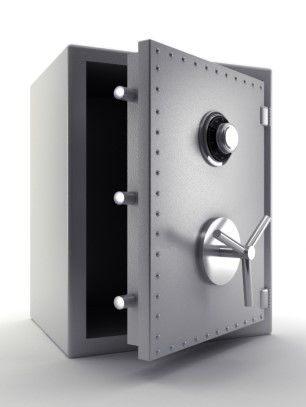Asbestos risks in safes and fire resistant cabinets
Updated September 2023

The following Information Note has been prepared to help clarify the risks involved regarding the presence of asbestos in some older models of safes and secure/fireproof filing cabinets and to give advice on how to manage the relevant risks while complying with the Exposure to Asbestos Regulations1.
Background
In the past and because of its useful fire-retardant properties, asbestos was used by certain safe and cabinet manufacturers as a door jointing seal in specific products. Asbestos was also sometimes contained in a packing or “barrier” material inserted and sealed during manufacture within the doors or walls of safes or cabinets.
It is known that asbestos was used by some safe manufacturers into the late 1990s. Therefore, it is prudent for safes and cabinets manufactured prior to 2000 to be checked to determine their asbestos containing status. Further advice is given below.
The Risks
An asbestos-containing door jointing seal often takes the form of a woven strip or tape attached to the door frame.
The potential presence of asbestos-containing barrier material sealed in the door or walls of a safe or filing cabinet should not present a risk of exposure during normal use of the safe or cabinet. If there is any evidence of a loss of containment of the internal packing/barrier material of a pre-2000 safe or fireproof cabinet, it must be taken out of service and remain undisturbed until the material is tested by an asbestos consultant or otherwise confirmed to be asbestos-free.
The original manufacturer of a particular pre-2000 make and model of safe or fireproof cabinet may be in a position to confirm that its internal packing/barrier material does not contain asbestos. Some leading brand manufacturers may give reassurances on their products going back several decades. Your local safe supplier/distributor may be able to assist in getting this information. Where the asbestos-free status of your pre-2000 safe or cabinet cannot be established or is uncertain, it must be presumed to contain asbestos.
A presumption of asbestos content will not affect the day-to-day usage of the safe or cabinet. However certain emergency safe opening practices such as destructive cutting of a safe must not be permitted as these activities could result in disturbance and release of asbestos fibres from the internal packing. Even non-destructive “precision drill opening” of a safe presumed to contain asbestos must be carried out under strictly controlled conditions (see below). Likewise, it is not considered safe to carry out any modification works on a safe presumed to contain asbestos if those works involve breaching the walls or door (e.g. for the retrofit installation of a slot deposit system).
Managing the Risks
If you are concerned that your pre-2000 safe or filing cabinet may have an asbestos jointing seal, you need to arrange for it to be checked by a competent asbestos consultant. The trained asbestos consultant will confirm whether asbestos is present or otherwise and can also advise on the necessary risk management measures. It is recommended that the jointing seal is removed and replaced by a specialist contractor under controlled conditions. It is important that any replacement seal is equivalent or better. These remedial measures are likely to be cost-effective in comparison with replacement of the safe.
For emergency opening of a safe presumed to contain an asbestos packing/barrier and which is fitted with a mechanical key or combination lock, employ a competent safe and vault technician, who is expert at manipulative or “pick” opening of safes without the need to drill. Most safes that are fitted with a mechanical lock can be opened by an expert technician without resorting to drilling. This should not present any risk of exposure to asbestos.
In the unusual event that precision drilling is deemed necessary to open the safe, it should be carried out by a competent safe and vault technician with the assistance of a specialist asbestos contractor. The role of the asbestos contractor is to manage the asbestos risk by capturing any dust arising from the activity with a suitable (hepa-filtered) vacuum device.
The task should be carried out in a controlled manner and should be subject to a thorough risk assessment to ensure that internal barrier material/dust is not released during or subsequent to the drilling operation. The safe technician will securely reseal the drill hole.
Placing of Second-Hand Safes & Fire Resistant Cabinets on the Irish market
The EU-wide ban2 on the marketing and sale of asbestos-containing products also applies to second-hand or refurbished safes and cabinets that contain or are presumed to contain asbestos.
End-of-life safes that are presumed to contain asbestos must be treated as hazardous waste and be subject to appropriate disposal requirements.
Footnotes
- Safety, Health and Welfare at Work (Exposure to Asbestos) Regulations 2006 and 2010
- Regulation (EC) No. 1907/2006 concerning the Registration, Evaluation, Authorisation and Restriction of Chemicals (REACH), as substituted by Commission Regulation (EC) No. 552/2009 and subject to any exemption granted by the Health and Safety Authority in accordance with the Chemicals (Asbestos Articles) Regulations, S.I. No. 248 of 2011